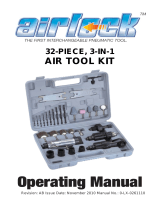PDEXS 150 C2
■ 16
│
US - ES
Peligro por proyección de piezas
■ En caso de rotura de la pieza, de los accesorios
o incluso de la herramienta de mecanizado, pue-
den salir proyectadas piezas a alta velocidad.
■ Al usar la lijadora o pulidora o al sustituir los ac-
cesorios de la máquina, hay que llevar siempre
protección ocular resistente a golpes. El grado
de la protección necesaria debe evaluarse en
cada uso individual.
■ Si se realizan trabajos por encima de la cabeza,
hay que llevar casco.
■ En este caso, también deben evaluarse los
riesgos para otras personas.
■ Hay que garantizar que la pieza esté bien sujeta.
Peligro por atrapamiento
■ Puede producirse asfixia, escalpelamiento u
otras lesiones por cortes si no se mantienen ale-
jadas de la máquina y sus accesorios prendas
sueltas, joyas, collares, cabellos o guantes.
Peligro durante el funcionamiento
■ Al utilizar la máquina, las manos del operador
pueden estar expuestas a lesiones, como cortes,
excoriaciones o quemaduras. Lleve guantes
adecuados para proteger las manos.
■ El operador y el personal de mantenimiento
deben ser físicamente capaces de trabajar con
las dimensiones, el peso y la potencia de la
máquina.
■ Sostenga la máquina correctamente:
esté preparado a contrarrestar los movimientos
habituales o imprevistos y tenga las dos manos
preparadas.
■ Preste atención a que su cuerpo mantiene el
equilibrio y tenga una postura segura.
■ Desbloquee el dispositivo de inicio y parada en
caso de una interrupción de la proveedor de
energia.
■ Utilice exclusivamente los lubricantes recomen-
dados por el fabricante.
■ Se deben usar gafas. Es el uso de guantes de
protección y se recomienda ropa de protección.
■ Compruebe el plato de lija antes de cada uso.
No lo utilice si presenta grietas, está roto o se
ha caído.
■ Evite el contacto directo con el plato de lija en
movimiento para no aplastar ni cortar las manos
u otras partes del cuerpo. Deben llevarse guantes
adecuados para proteger las manos.
■ No utilice nunca la máquina sin lubricante.
■ Existe el riesgo de una descarga electrostática
si se utiliza la máquina sobre plástico y otros
materiales no conductores.
■ Puede crearse una atmósfera potencialmente
explosiva a causa del polvo y los vapores cau-
sados por el pulido y el lijado. Debe utilizarse
siempre un sistema de supresión o aspiración
del polvo adecuado al material que se va a
procesar.
Peligro por movimientos repetidos
■ Al utilizar una lijadora o pulidora para realizar
actividades laborales, el operador puede notar
molestias en manos y brazos, así como en la
zona de cuello y hombros o en otras partes del
cuerpo.
■ Al utilizar una lijadora o pulidora, el operario
debe tener una postura cómoda y segura y
evitar posiciones incómodas o en las que es
difícil mantener el equilibrio. En caso de traba-
jos prolongados, el operador debe cambiar de
postura para evitar molestias y cansancio.
■ Si el operario nota síntomas como malestar
continuo o repetido, molestias, pálpitos, dolor,
hormigueo, entumecimiento, quemazón o
rigidez, no debe ignorarlos. En este caso, el
operador debe buscar asistencia médica.
Peligro por accesorios
■ Desconecte la lijadora o pulidora de la corriente
eléctrica antes de sustituir la herramienta de
mecanizado o los componentes.
■ Evite el contacto directo con la herramienta de me-
canizado durante y después del uso, ya que puede
haberse calentado o tener bordes cortantes.
■ Solo deben utilizarse herramientas de meca-
nizado para lijadoras o pulidoras que hayan
sido aprobadas por el fabricante de la lijadora
o pulidora.
■ No se pueden utilizar muelas para tronzar ni
máquinas de corte.





















